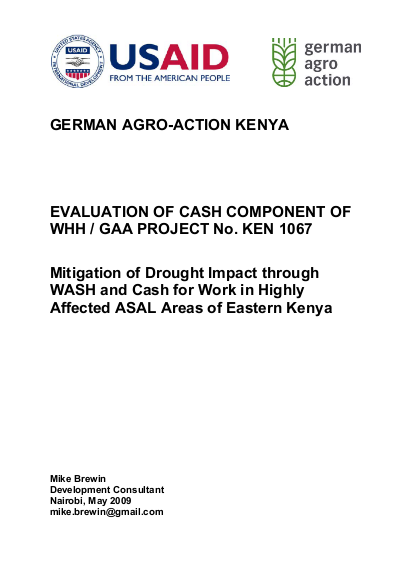EVALUATION OF CASH COMPONENT OF WHH / GAA PROJECT No. KEN 1067

GAA’s ‘Mitigation of Drought Impact through WASH and Cash for Work in Highly Affected ASAL Areas of Eastern Kenya Project’ (Project number KEN1067) was implemented in Mwingi District between June 2009 and September 2010 at a cost of $1.5m. Funding was provided by the US Government’s Office of Disaster Assistance (OFDA). The project’s overall goal of ‘supporting poor rural communities to protect their livelihoods during an acute drought, strengthen their food security and mitigate future shocks’ pursued through the objective of ‘mitigating drought impacts and increasing resilience through enhanced water structures for human beings and animals, through improved hygiene practices, and through cash injections into vulnerable HH’. Overall, 70,000 food insecure poor marginal farmers and agro pastoralists were targeted.
At an activity level, the project aimed to achieve the following targets:
- Complete rehabilitation of 5 earth dams;
- Complete rehabilitation of 1 concrete dam;
- Complete construction of 17 new earth dams
- Complete construction of 31 sub-surface and sand dams
- Construction of 2 rock catchments
- Rehabilitation of 1 spring catchment
- Rehabilitation of 1 rock catchment
- Beneficiaries at all sites trained in M&O, O&M and hygiene promotion
A large portion of the labour necessary to build these structures was provided by local communities on a cash-for-work (CFW) basis, the intention being that, as well as developing assets of value to the community, participating households would, at least for a limited period, have an income which could be used to buy food or service other essential consumption needs. Where special skills were needed local artisans were employed, but a major factor in the choice of projects was their ability to supply unskilled labour opportunities to the local population.
Essentially, the project aimed to address communities’ long-term water needs while at the same time providing some immediate assistance to stabilise household-level consumption.